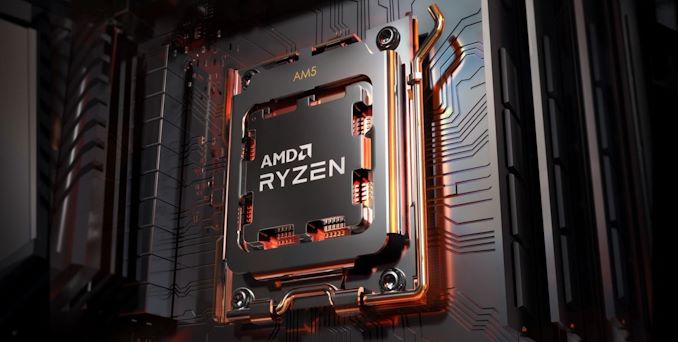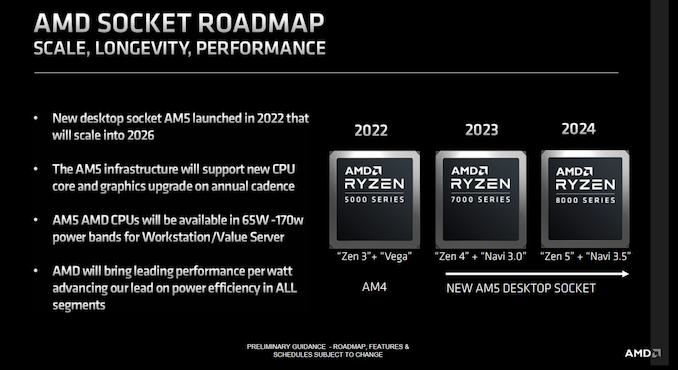AMD Confirms AM5 Support For Ryzen 8000 Processors, Zen 5 with Navi 3.5
by Gavin Bonshor on June 5, 2023 5:00 PM EST- Posted in
- CPUs
- AMD
- Motherboards
- Zen 5
- AM5
- Granite Ridge
- Zen 5c
- Ryzen 8000
- Navi 3.5

During one of their webinars to channel partners on maximizing server deployments with AMD Ryzen processors, AMD unveiled some of the upcoming plans surrounding their next-generation Zen 5 microarchitecture. Although we know the broader AMD desktop roadmap up until 2025 and their plans to launch Zen 5, codenamed 'Granite Ridge' sometime in 2024, AMD has produced a slightly updated roadmap. Within this roadmap is details announcing that their AM5 platform will officially support upcoming Zen 5 processors.
On top of this, AMD has unveiled that the Zen 5 desktop processors will fall under the Ryzen 8000 series family, but with a twist, as Zen 5 will also come with a new iGPU codenamed 'Navi 3.5.' The last of the potential announcements is that we could see Ryzen 7000 series processors with RDNA 3 (Navi 3x) based integrated graphics later this year.
Despite there being little technical information from AMD on their upcoming Zen 5 (Granite Ridge) based processors, which are scheduled for sometime in 2024, AMD has let the cat out of the bag. This includes a couple of significant (albeit stealthily hidden) confirmations about its next-generation platform. The first of these confirmations is that AMD's Zen 5 for desktop products will come under the Ryzen 8000 series, the direct successor to AMD's current Zen 4-based Ryzen 7000 series for desktops.
AMD's Ryzen 8000 desktop family of processors, as we now know it to be, will incorporate three primary lineups. This includes the regular desktop CPUs and at least one but maybe more Zen 5-based processors with 3D V-Cache packaging. The third is a lower powered, lower spec, and more compact core known as the Zen 5c series, which we know from the case of Zen 4c, is used in AMD's EYPC 128-core Bergamo processor.
On top of the Ryzen 8000 naming confirmation, AMD has also unveiled that their current AM5 platform for motherboards will also support the upcoming Zen 5-based processors and that the AM5 socket will scale into 2026; AMD's motherboards sockets for generations have had periods of longevity and stability with new processor launches, and AM5 looks to be no different in this regard. This means users with Ryzen 7000 and AM5-based motherboards such as X670E and B650E could theoretically drop the upcoming Ryzen 8000 chips straight into the socket and enable use through a firmware update. AMD, however, hasn't confirmed this as of yet.
The other interesting disclosure is that AMD's Ryzen 8000 series won't come with RNDA 3-based integrated graphics but with a new codename that insinuates an update to their existing Navi 3 products is also in the pipeline. This is named Navi 3.5, and although there are no official details on what AMD GPU architecture they will be based on, or the specifications, we should find out more on this closer to Zen 5's launch, which, again, is scheduled for 2024.
The most significant feature of AMD's slightly updated roadmap is that it shows AMD Ryzen 7000 series (Zen 4) processors with Navi 3.0 graphics. Given that AMD's currently released Ryzen 7000 series processors, such as the Ryzen 9 7950X, have an RDNA 2-based integrated graphics chip (Navi 2x), this could be the most evident disclosure yet from AMD that Ryzen 7000-based 'APUs,' a term which AMD has seemingly moved on from, could be released later this year. There is also a chance this could be a blooper in AMD's roadmap.
Still, it remains to be seen whether or not we get a Zen 4-based SoC with better-integrated graphics that we've been accustomed to from previous generations of Ryzen processors.
Source: AMD











9 Comments
View All Comments
nandnandnand - Monday, June 5, 2023 - link
I didn't hope for any more than an RDNA2 iGPU in Granite Ridge (reused I/O die). Time to throw in XDNA as well?StevoLincolnite - Monday, June 5, 2023 - link
Wondering when AMD will start to include A.I accelerated processing on their CPU's to chase the same money bags nVidia currently is?nandnandnand - Monday, June 5, 2023 - link
An XDNA AI accelerator is already in Phoenix, so it would automatically be included in any Phoenix desktop APU.They have made the usual non-committal statements indicating they want AI in everything, but not guaranteeing it will come to any particular product lines right away. So maybe XDNA will be in Granite Ridge Zen 5 desktop CPUs, maybe not.
brucethemoose - Tuesday, June 6, 2023 - link
XDNA as they market it in Phoenix is for low power inference, not necessarily even IGP beating performance. Its not really the same market Nvidia is chasing.The more promising AMD (and Intel) AI thing is the rumored quad channel APU.
pogsnet - Friday, June 16, 2023 - link
Phoenix APU found on AMD PRO Laptops can do AI processing. It make AI processing faster and accurate says BARD AIlightningz71 - Tuesday, June 6, 2023 - link
Since AMD uses common building blocks for their CPU and GPU products, it only makes sense that the 8000 series lineup uses RDNA 3.5. Their 3.5 IP will be based around a TSMC N4 process technology and it looks like the IO Die will be moving to that tech in the next generation. They would either port RDNA 3.0 to N4, or just reuse the cell designs from their N4 GPUs instead.nandnandnand - Wednesday, June 7, 2023 - link
It doesn't automatically make sense. Ryzen 7000 used an N6 I/O die with RDNA 2. They could have just reused that one for Ryzen 8000, but I guess not. RDNA 3 has appeared on N4 (Phoenix), N5 (Navi 31), and N6 (Navi 33). There's probably nothing stopping AMD from keeping the I/O die at N6, if that's what they want to use to save a few bucks.scineram - Thursday, June 8, 2023 - link
Yes, I also expect N6 for that.scineram - Thursday, June 8, 2023 - link
So Phoenix for AM5 confirmed, cool. Looking at an upgrade for my itx system.